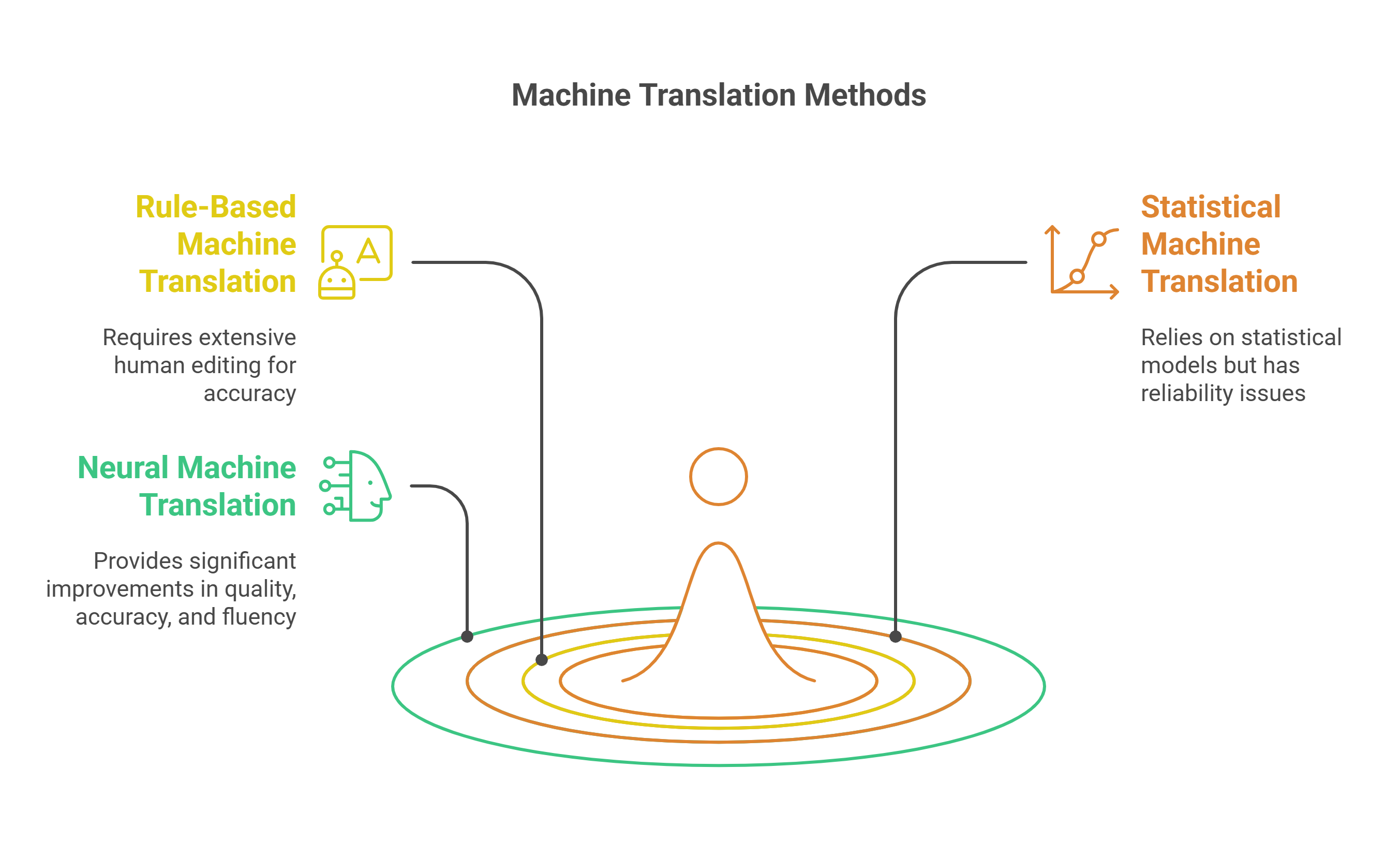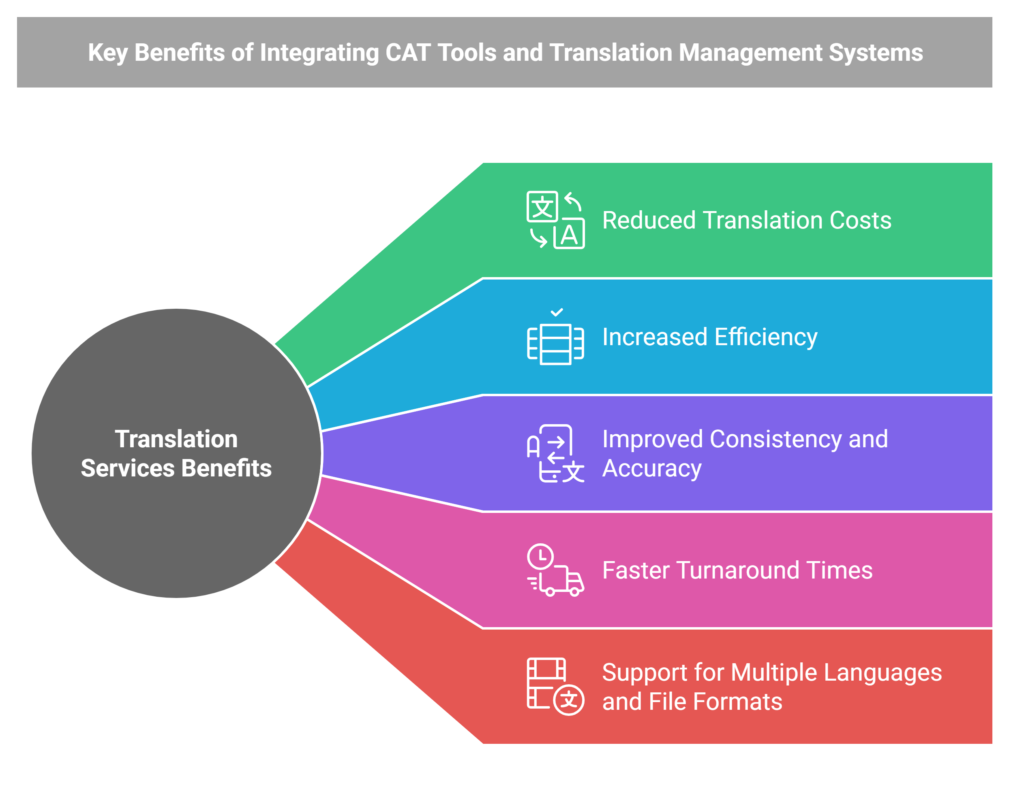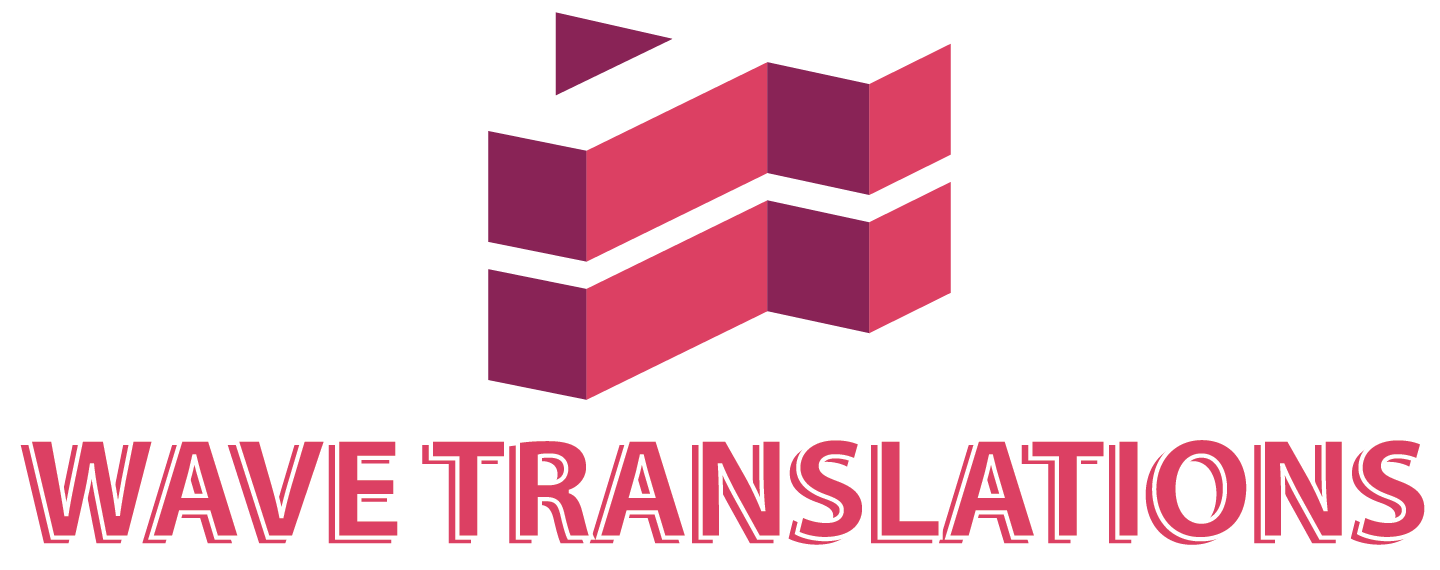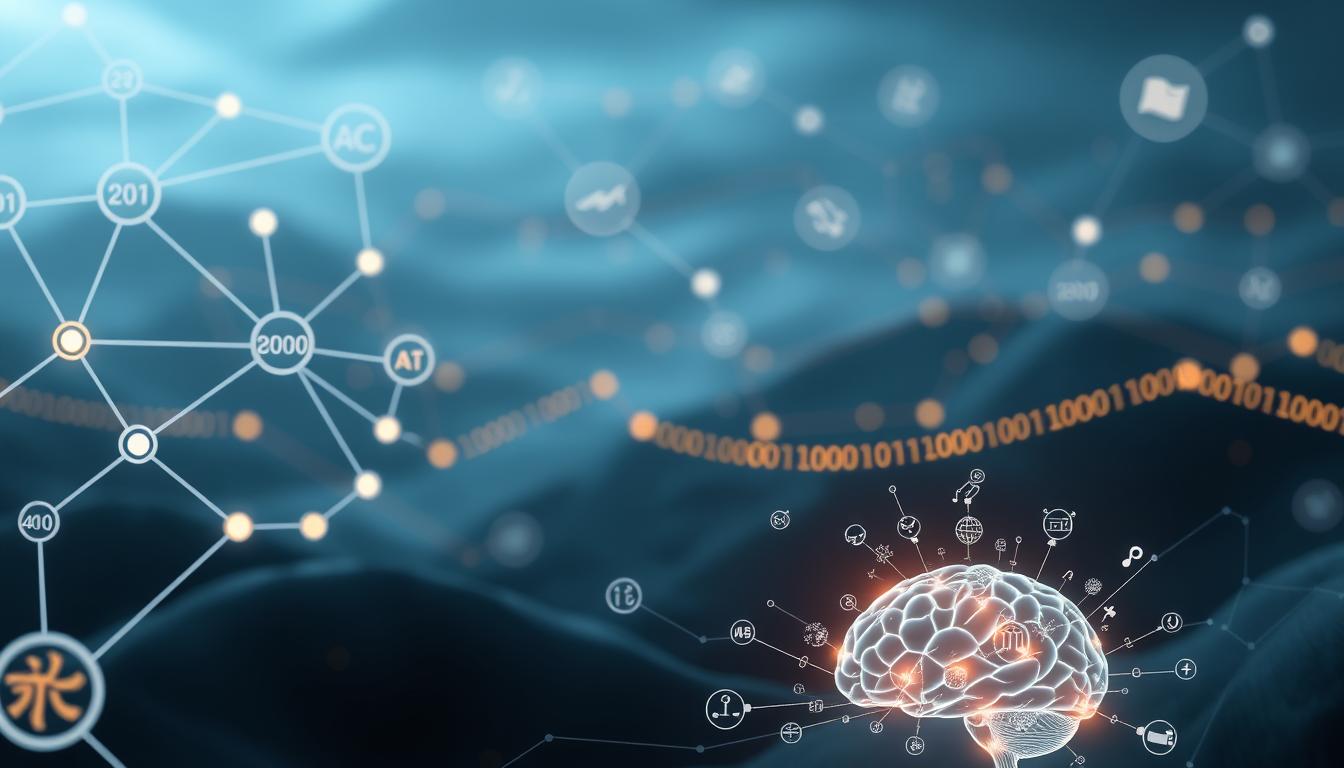Machine translation, powered by artificial intelligence, is changing the language services industry. It makes translations faster and more accurate. This technology is key to the industry’s growth, with AI software spending expected to hit $297 billion by 2027.
Artificial intelligence is making multilingual talks smoother. It recognizes human communication patterns for a natural flow. AI-powered translation tools also reduce delays in conversations.
The mix of (Artificial Intelligance) Ai and machine translation and language processing is changing how we talk across languages and cultures.
Machine translation post-editing roles are becoming more popular. There’s a big need for post-editors to improve machine-generated translations. AI is getting better at translating, using stats and past data for better results.
But, the role of AI in language services goes beyond just translation. It also makes multilingual talks better and improves translation quality.
Understanding Machine Translation
Machine translation is key in translation tech, using smart algorithms to translate text from one language to another. It has grown a lot, thanks to neural networks. These advancements have made translation systems better over time.
The main parts of machine translation systems are pre-translation, translation, and post-translation. These steps help make sure translations are accurate and fast. Neural networks have also made translations better, helping both businesses and people.
Machine translation services saves money and works faster. It can cut costs by up to 70% compared to old ways of translating. It’s also great for handling lots of data, which is perfect for big businesses.
In short, knowing about machine translation is key in today’s world. By using tech and neural networks, companies can talk to more people and grow their reach.
The Science Behind Modern Machine Translation
Modern machine translation uses artificial intelligence, language processing, and automated translation. This makes it fast and accurate. Machines can now understand and translate text with great precision.
The rise of neural machine translation services has made older methods less relevant. It can handle different domains like legal and medical. This means it learns specific words and styles for each area. AI also gets better over time as it learns from more data.
Modern machine translation offers several benefits:
- It’s more accurate, with AI models up to 30% better than old methods in tricky sentences.
- It’s faster, with industries seeing a 30% speed boost without losing quality.
- It saves money, cutting localization costs by up to 40% in some markets.
Types of Machine Translation Systems
Machine translation systems have changed a lot over time. Now, we have different types for various needs and languages. The first type was Rule-Based Machine Translation (RBMT), which needed a lot of human editing.
But, new technology brought us Statistical Machine Translation (SMT) and Neural Machine Translation (NMT).
Neural Machine Translation (NMT) is the most precise option. It gets better with more training data. Neural networks have changed machine translation. They make automated translation faster and better. Here’s what each type of machine translation system is like:
- Rule-Based Machine Translation (RBMT): Needs a lot of human editing
- Statistical Machine Translation (SMT): Uses statistical models but has reliability issues
- Neural Machine Translation (NMT): Offers a big quality boost, with better accuracy and fluency

The Role of Artificial Intelligence in Translation
In the world of AI, we have machine translation services that read the text properly and translate it correctly.
This tech is key for businesses and people to get better, faster translations. It automates language processing, speeding up and improving translation quality.
Machine learning is a big part of AI in translation. It lets machines learn from lots of data and get better at translating over time. This tech could change the translation world, helping businesses talk better with customers and partners globally.
But, AI in translation also has its hurdles. For instance, machine translation can miss the subtleties of human language, leading to mistakes. It also makes us wonder about the future of human translators in this field.
Despite these issues, AI in translation is getting more common. Many businesses and people use machine translation to talk to customers and partners worldwide.
Benefits of Machine Translation in Today’s Global Market
Machine translation services brings many benefits, like saving money and growing with your business. It’s perfect for companies working worldwide. This tech helps cut down on how long it takes to translate and the cost, letting you reach more people faster. It’s great for big projects, like translating websites, because it’s faster and cheaper than human translators. Some of the main perks of machine translation are:
- Cost efficiency: Reduces expenses by automating bulk translations, minimizing reliance on pricey human translators for routine tasks.
- Multilingual scalability: Supports 50-100+ languages simultaneously, enabling rapid content localization for diverse markets.
- Operational speed: Processes millions of words within seconds, crucial for real-time customer interactions and urgent document handling.
- Consistency management: Customizable engines maintain brand voice across translations using company-specific terminology.
- Data processing power: Analyzes multilingual user-generated content (social media, reviews) for actionable market insights.
- 24/7 global support: Powers instant translation of customer queries, emails, and chat services across time zones.
- Agile market entry: Accelerates product launches by localizing marketing materials and technical documents rapidly.
- Competitive edge: Enables smaller firms to compete internationally through affordable localization strategies.
Common Challenges and Limitations
Machine translation systems have many challenges and limitations. They struggle to grasp nuances and cultural references. This can cause mistranslations and misunderstandings, mainly in languages with complex grammar or cultural-specific terms. For example, over 80% of slang can be misinterpreted when translated directly.
Another issue is their inability to understand word relationships and context-dependent honorifics. Despite these challenges, machine translation can be useful for quickly translating large amounts of text. It’s important to know these limitations and use it with human editing and review for better accuracy and quality.
Post-Editing Machine Translation
Post-editing is key in machine translation services, making sure the content is of high quality. It combines human skill with machine speed, improving translation accuracy. This way, large amounts of content can be processed quickly.
There are two main types of post-editing: light and full.
- Light post-editing can be 50% to 200% faster than human translation.
- Full post-editing is 25% to 50% faster.
Quality checks are vital in post-editing machine translation. They involve reviewing and revising the content to meet standards. Post-editors should follow ISO guidelines for consistency and quality. This ensures the translations are accurate and effective.
Post-editing is essential in machine translation. Understanding its types, quality checks, and best practices helps businesses improve their translations. This leads to better communication with customers and partners.
Machine Translation in Different Industries
| Industry | Application of Machine Translation |
| E-commerce | Translating product descriptions, customer reviews, and marketing materials for global audiences. |
| Healthcare | Translating medical records, research papers, and patient communication for cross-border care. |
| Legal | Translating contracts, compliance documents, and multilingual litigation materials. |
| Military & Defense | Real-time translation for tactical communication and multilingual intelligence analysis. |
| Automotive | Technical manuals, user guides, and global supply chain communication localization |
| IT & Software | Localizing software interfaces, technical documentation, and developer tools. |
| Education/eLearning | Translating eLearning courses, training materials, and multilingual educational content. |
| Entertainment & Media | Audio subtitle, dubbing, and transcreating movies, TV series, and video games |
Integration with CAT Tools and Translation Management Systems
Machine translation works well with CAT tools and translation management systems. This makes the translation process smoother and better. It helps businesses save money and work faster.
Using CAT tools, translators can use old translations to make new ones better. This makes the work faster and more accurate. CAT tools also handle many file types, making translators’ jobs easier.
These tools support over 115 languages. This means businesses can reach more people around the world quickly. It’s great for those who want to grow globally.
Working with machine translation, CAT tools, and translation management systems makes things better. It helps businesses get to their goals faster. They can work together on big projects without delays.
By using these tools, businesses can do better translations. This helps them meet their global marketing goals. A good CAT tool can cut translation time in half without losing quality, says the second web source.
Good terminology management keeps translations consistent. It makes sure words like “card” are translated right, not wrong. Quality checks can find errors automatically, cutting down manual mistakes by up to 80%.

The Human Element in Machine Translation
Machine translation services is not perfect yet. It is important to make sure that the translation is right and of good quality. Having humans help with machine translation is key, even for important content. A study found that when humans edit machine translations, the quality goes up by 40%. This proves that working together between humans and machines is the best way to get great translations.
In short, the human touch is essential in machine translation. By using the best of both humans and machines, we can create top-notch translations. These translations will meet high standards and effectively convey the intended message.
| Benefits of Human Involvement | Machine Translation | Human Translation |
|---|---|---|
| Accuracy and Quality | 90% | 99% |
| Cultural Nuances and Context | 80% | 95% |
| Efficiency and Productivity | 85% | 90% |
Quality Metrics and Performance Evaluation
When we check the quality of machine translations, we look at several important metrics. BLEU scores help us see how accurate and smooth translations are. Other tools like METEOR and TER also help us understand how well translations make sense. A study showed that native speaker opinions match better with METEOR and ROUGE-L than BLEU.
| Metric | Description |
|---|---|
| BLEU | Assesses the accuracy and fluency of translations |
| METEOR | Evaluates the coherence and overall quality of translations |
| TER | Calculates the number of edits required per reference word |
Using these metrics is key to making sure machine translations are up to par. This is very important in fields like e-commerce and healthcare. Here, clear and precise translations are vital for building trust and clear communication.
Machine Translation for Multilingual Content Strategy
Understanding machine translation is key to reaching global audiences. It helps businesses create and manage content in many languages. This way, they can talk to customers all over the world. It lets companies grow and connect better with their customers, as 60% of online shoppers shy away from English-only sites.
Machine translation services is a big part of a good multilingual content strategy. It helps make content that feels personal to each customer. Using machine translation can make a business’s online presence stronger. It can also make customers more loyal and increase sales, as 86% of campaigns that use local languages do better than English-only ones.
A good multilingual content strategy with machine translation can really help a company grow. It lets them connect with people all over the world and boost their business.
Future Trends in Translation Technology
The translation industry is set for big changes soon. New technologies and trends will lead the way. Over 700 translation solutions are already out there, showing a need for better tools. Artificial intelligence and machine learning will make translations faster and more accurate, becoming key in the future.
New tech like neural machine translation and cloud-based systems will change the game. They promise to make work more efficient and translations quicker. AI software can also cut costs and make translations more consistent, which is great for businesses.
As global trade and communication grow, so will the need for quick and precise translations. New tech will keep improving, making translations better, faster, and cheaper.
Security and Privacy Considerations
Using machine translation services requires careful thought about security and privacy. Free online translation services can expose sensitive information, posing big risks for confidential documents. Data breaches are becoming more common, and companies must ensure accurate and confidential legal document translations to avoid legal and financial issues.
Various services use privacy protocols in their machine learning to improve translation accuracy without risking client data. Regular security audits are also key to keep up with security practices and protect customer info.
By focusing on security and privacy, businesses can safely use machine translation services. This protects sensitive information and keeps them in line with important regulations.
The Evolving Landscape of Machine Translation
Machine translation is on the edge of a big transformation. NMT (neural machine translation) systems will give us more accurate and fluent translations. Plus, Automatic Speech Recognition (ASR) technology is getting better as time goes on, improving the accuracy of transcriptions.
The need for machine translation services from professional translation services from Wave Translations is in high demand today because of globalization and technological advancement. Old ways of translating can’t keep up with fast industries, so machine translation is stepping in. AI tools are getting better at understanding context and cultural details, helping us communicate better in real time.
Even though machine translation has made great strides, we can’t forget the importance of human touch. In fields like law, medicine, and tech, we need people to check and edit translations. With new tech like augmented and virtual reality, machine translation is set to change how we talk and work together across languages.
FAQ
What is machine translation?
Machine translation services uses computer software to translate text from one language to another. It does this without any human help.
What are the benefits of using machine translation?
Machine translation saves money and time. It’s great for big projects and keeps translations consistent.
How does artificial intelligence (AI) impact language services?
AI, like machine learning and natural language processing, makes machine translation better. It improves accuracy and speed.
What are the different types of machine translation systems?
There are rule-based, statistical, and neural machine translation systems. Each has its own strengths and weaknesses.
What is the role of post-editing in machine translation?
Post-editing is key to quality. It involves human translators fixing errors and making sure translations are right.
How can machine translation be used in different industries?
Machine translation helps in law, medicine, and finance. It lets businesses talk to global customers better.
How can machine translation be integrated with CAT tools and translation management systems?
Integrating machine translation with CAT tools and translation management systems improves workflow. It also boosts translation quality.
What are the common challenges and limitations of machine translation?
Machine translation services struggles with nuances and cultural references. It also needs human touch for top-notch translations.
How do quality metrics and performance evaluation affect machine translation?
Quality metrics, like BLEU scores, check how well machine translation works. They compare it to human translations.
What are the security and privacy considerations in machine translation?
Businesses must keep their machine translation systems safe. They need to follow rules to protect data and privacy.

